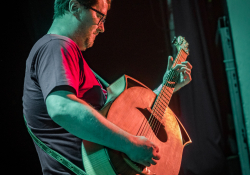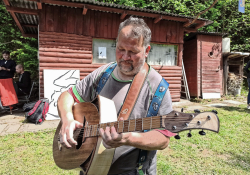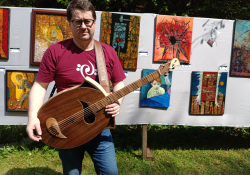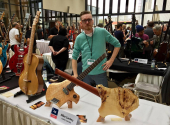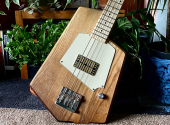
Dreamstruments #30: ReBell Eli BAR
In the jubilee episode of our Dreamstruments series, we can now afford a slight change of the concept and take a closer look at one particular dream come true. Incidentally, the articles on the Czech version of our e-zine Frontman played an important role in this story. So let's present the birth of an unconventional deep ellipse full of innovative solutions and unbridled creativity – ReBell Eli BAR.
We have already met the guitar maker Peter Taks in the Dreamstruments. He approached me during the COVID period just thanks to the series published on Frontman and started consulting me about various unconventional details and solutions. I served as a kind of knowledgebase for him, and I, in turn, tested him out not only on minor repairs but also on obscure tweaks (such as a Japanese koto-style guitar sound system). So we gradually started being on the same wavelength and discussed the concept of the ultimate stage baritone guitar.
The cornerstone of the design was a lecture by a theoretical physicist doc. Mojžiš about elliptic curves and their surprising manifestations in the world around us. For example, can you think of how the average height of North American natives might be related to the frequency of weddings in Belgium, or secondary sex characteristics to the evolution of the most powerful weapon in history – the human brain? The curves of bells and amphorae, discussed from various perspectives, had served ReBell as the basis for unconventional guitars until it was the turn of the most interesting of them all – the ellipse.
Mr. ReBell was naturally intrigued by the use of the ellipsoidal shape of the American library for unobtrusive eavesdropping or the elliptical bathtub for breaking kidney stones with ultrasound. But most importantly by the fact that light or sound coming from one focal point always reliably ends up in the other, so if we put a bridge in one place and a soundhole in the other, it has to work perfectly!

So we set out a basic direction, but that was just a tentative start, because the ellipse is a beautiful shape, but it's also ergonomically completely inappropriate. We were thinking and trying for a long time about how to visually grasp it, until a very radical shape crystallized with two "ears" usable for subtly shaped soundports, as well as physical-aesthetic support while playing, then visually balanced by a yin/yang bridge/soundhole.
After the Taylor Roadshow, I wanted to try the ovangkol, better known in the Czech Republic used in vintage furniture. It's a very interesting wood, with the dense sparkle of rosewood and the legible centers of mahogany, beautiful grain and colour. For visual contrast, we complemented it with light flame maple, and for the fretboard and bridge, we used a thickened beech obtained from old socialist textile industry stocks. Thanks to thermo-chemical-physical processes, the so-called lignamon acquires many times better mechanical properties and was used not only for the shuttles of knitting looms, but also for gun butts or wagon floors, and can therefore match hard exotic woods.

Then followed a fireworks display of wild construction details, which we had to correct a bit to make sure it wasn't a caricature. So, from the subtle sides made of resonant spruce, to the neck-through supporting bass frequency transfer (but also the rigidity of the sound cabinet), to the massive inner heel lightened by the ellipse-shaped opening, a specially shaped outer heel for more comfortable access to higher positions, an angled body according to Linda Manzer and an armrest for greater comfort, to the bridge powerpins, modified DIY for baritone strings (because the manufacturer did not respond to our inquiries). But these are not so exceptional details, so we turned up the heat and placed a spherical sound wave diffuser under one focal point of the ellipse at the neck-through and a "ski jump" under the other focal point for sound jump...
The result is an absolutely unique instrument, suitable primarily for majestic fingerstyle, but capable of handling wild baritone slaps or utter disparagement of legendary hits. The ReBell Eli BAR is everywhere arousing shocking interest in how such a horror/beauty (strike out inapplicable) can play at all. Its main trump card, however, is its stage sound, which we spent countless hours discussing and testing.
In the end, the Artec magnetic pickup (good sound and small size) combined with the little-known Schatten Dualie plate pickup won out. As I discussed earlier in The Handbook for Electro Acoustic Guitarists, a stage guitar doesn't need to (or rather shouldn't) be sonically dazzling on its own, because then it's more difficult to amplify it. That's the case with this ellipse, the acoustic sound of which doesn't evoke the same gusts of enthusiasm as its design, but when plugged in, even sound engineers rate it as "beautiful" or even "divine". It is thus my only acoustic guitar that sounds significantly better through pickups than miked.
Of course, despite careful preparation, we may not be able to sort out everything up front, and we encountered a magnetic pickup that produced considerable hum at louder volumes. And that was quite a predicament, as its size was matched by a sleek design with an ovangkol cap cut from the same spot on the soundboard.
I was saved by another participant in the Dreamstruments series, Radovan Macho, who made a hum-free single-coil from a poorly shielded single-coil pickup with a parasitic coil added. Of course, this affected the sound a bit, but as we know from The Handbook, a magnetic pickup is never a complete miracle. However, the combination with a plate Schatten with a much more "microphonic" sound works great.
The icing on the elliptical cake then was the final satin finish with linseed oil lacquer, where the large pores of the dark ovangkol were filled with cocoa by ReBell! Even I still get surprised from time to time. Not even the post-covid unavailability of suitable tuning machines throughout Europe did put us in a bad mood. We finally managed to find and get a Gator gigbag that was wide enough in the spot where all other guitars are narrowest. It's also good to think a little bit ahead, but after two years of intense work, we managed to get everything right. The stylish Eli logo unconventionally placed on the side, but of course in the shape of an ellipse, graphically closed the story.
So don't be afraid to pursue your wild dreams – and maybe get inspired and encouraged by this series.
If you have found an error or typo in the article, please let us know by e-mail info@insounder.org.

